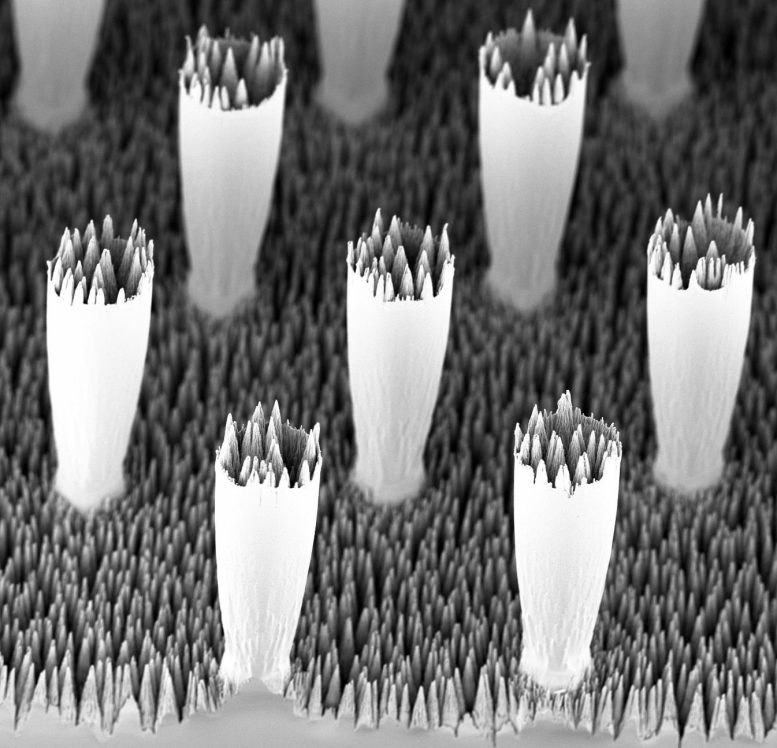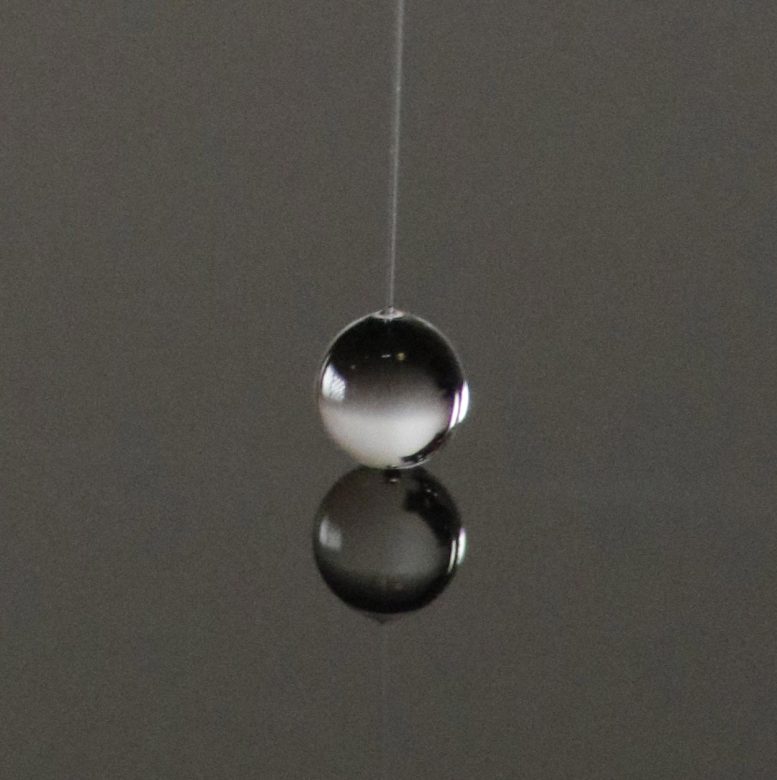Assistant Professor of Physics Matilda Backholm’s unique micropipette force sensor technology detects the tiny forces acting between superhydrophobic materials and water droplets.Image credit: Matilda Backholm/Aalto University
Using a novel force measurement technique, researchers at Aalto University have discovered a new force acting on water droplets moving on superhydrophobic surfaces such as black silicon, revealing previously unknown physical principles. This force, known as air shear, challenges previous understanding and suggests modifications to the design of these surfaces to reduce drag, potentially improving their efficiency and applications in a variety of fields.
Microscopic cracks that form a sea of conical, jagged peaks dot the surface of a material called black silicon. While black silicon is common in solar cell technology, it can also be used as a tool to study the physics of water droplet behavior.
Black silicon is a superhydrophobic material, meaning it repels water. Due to the unique surface tension properties of water, water droplets slide through textured materials such as black silicon through the gaps in the thin air film trapped underneath. This method works very well when the water droplets are moving slowly – they glide smoothly.
But as the drop moves faster, there seems to be some unknown force pulling on its lower belly. This has baffled physicists, but now a team of researchers from Aalto University and ESPCI Paris has an explanation, and they have the data to back it up.
Matilda Backholm, assistant professor at Aalto University, is the lead author of a paper detailing the findings, published April 15 in the journal Proceedings of the National Academy of Sciences. She conducted this research while working as a postdoctoral researcher in Professor Robin Ras’ Soft Matter and Wetting Group in the Department of Applied Physics.

The Aalto University research team’s solution to air shear forces is to build pillars on a black silicon surface and then etch them into caps with a similar texture.Photo credit: Maja Vuckovac/Aalto University
“When looking at water surface interactions, there are typically three forces at play: contact line friction, viscous losses, and air resistance. However, a fourth force is created by the movement of droplets on highly smooth surfaces such as black silicon. This motion actually creates a shearing effect on the air below, creating a drag-like force on the droplet itself. This shearing force has never been explained before, and we were the first to discover it. “Buckholm said.
It turns out that the complex interactions of fluid and soft matter physics are difficult to reduce to ready-made formulas. But Backholm succeeded in developing a technique to measure these tiny forces, explain how the forces work, and ultimately provide a solution to eliminate drag altogether. Hook, line and sinker.
air shear effect
Creating better superhydrophobic surfaces will make the world’s transportation systems more aerodynamic, medical devices more sterile, and generally improve the smoothness of anything that requires a waterproof surface.
Black silicon uses the specific surface tension of water to minimize contact between water droplets and the surface. Cones etched into the substrate allow water droplets to slide across the air-film space, called the plastron. But counterintuitively, the same mechanism that allows hydrophobic surfaces to deflect water droplets also causes the shear effects outlined in Backholm’s paper.

Detect water droplets with a micropipette force sensor.Image credit: Matilda Backholm/Aalto University
“The field has been making these ultra-smooth surfaces by reducing the length scale of the cones, making them smaller and richer. But no one stopped to realize, ‘Hey, we’re actually working against ourselves.’ “In fact, etching shorter cones on the black silicon surface creates a greater air shear effect,” said Backholm.
Other researchers have noticed the existence of this force but have been unable to explain it. Backholm’s discovery prompted a rethinking of how ultra-slippery surfaces are designed. Her team’s solution was to add taller cones with textured caps on the black silicon surface to further minimize the total contact surface area of the droplets.
“This work builds on the Soft Matter and Wetting research group’s extensive expertise on the topic of superhydrophobic surfaces. There are few opportunities to fully explain the subtleties of microscopic forces in wetting dynamics, but this paper does exactly that That,” Ras said.
Professional measurement technology
Backholm used a unique micropipette measurement technique to measure the force acting on the water droplets. She is an expert in these micropipette force sensors, having used them to measure the growth dynamics of plant roots, to scrutinize the swimming behavior of shrimp schools, and now to observe the force of moving water droplets.
After painstaking fine-tuning, she was able to use the technique to achieve a breakthrough in identifying shearing effects. Backholm oscillates the droplet and probe to detect subtle pulling forces below.
“By performing the same tests on carbonated droplets, we also ruled out the possibility that there were any other forces at work at the contact line. These droplets continuously release carbon dioxide, leaving them slightly suspended above the surface on which they sit. Nonetheless, The shear effect was measured again at a certain speed, conclusively confirming that this force acts independently of its contact with the black silicon surface,” said Backholm.
Backholm expects these findings will further help physicists and engineers develop better-performing hydrophobic surfaces.
Backholm now leads the Living Matter Research Group in the Department of Applied Physics.
Reference: “Towards elimination of droplet friction on repulsive surfaces” by Matilda Backholm, Tytti Kärki, Heikki A. Nurmi, Maja Vuckovac, Valtteri Turkki, Sakari Lepikko, Ville Jokinen, David Quéré, Jaakko VI Timonen and Robin HA Ras ”, April 15, 2024 Proceedings of the National Academy of Sciences.
DOI: 10.1073/pnas.2315214121
#physics #work #Physicists #discover #force #acting #water #droplets #moving #superhydrophobic #surfaces
Image Source : scitechdaily.com
